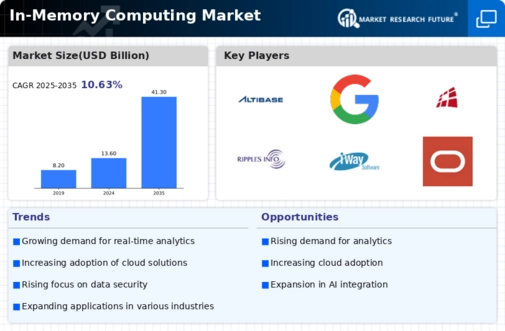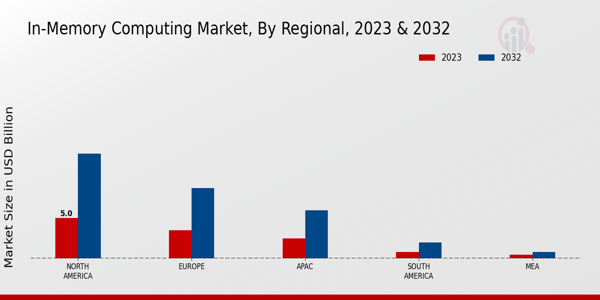Market Growth Projections
The Global In-Memory Computing Market Industry is projected to witness substantial growth over the coming years. With an estimated market value of 13.6 USD Billion in 2024, the industry is expected to expand at a compound annual growth rate (CAGR) of 10.65% from 2025 to 2035. By 2035, the market could reach approximately 41.3 USD Billion, reflecting the increasing adoption of in-memory computing solutions across various sectors. This growth trajectory indicates a robust demand for technologies that facilitate real-time data processing and analytics, positioning in-memory computing as a critical component of modern data strategies.
Growth of Big Data Analytics
The proliferation of big data analytics significantly influences the Global In-Memory Computing Market Industry. Organizations generate vast amounts of data daily, necessitating advanced computing solutions to analyze and derive insights efficiently. In-memory computing allows for the processing of large datasets at unprecedented speeds, enabling businesses to uncover trends and patterns that inform strategic decisions. The market is expected to grow substantially, reaching 41.3 USD Billion by 2035, driven by the increasing reliance on data-driven insights across industries. As companies seek to leverage their data assets, the demand for in-memory computing technologies is poised to rise, reflecting a broader trend towards data-centric operations.
Advancements in Cloud Computing
The integration of in-memory computing with cloud technologies is reshaping the Global In-Memory Computing Market Industry. Cloud platforms provide scalable resources that complement in-memory computing's speed and efficiency, allowing organizations to deploy applications that require rapid data processing without the constraints of traditional infrastructure. This synergy is particularly beneficial for businesses looking to optimize their operations and reduce costs. As cloud adoption continues to grow, the in-memory computing market is likely to experience a corresponding increase in demand, driven by the need for agile and responsive computing solutions. The combination of these technologies may lead to innovative applications across various sectors.
Need for Enhanced Customer Experiences
The Global In-Memory Computing Market Industry is increasingly influenced by the need for enhanced customer experiences. Businesses are leveraging in-memory computing to analyze customer data in real-time, allowing for personalized interactions and improved service delivery. For instance, retail companies utilize in-memory solutions to track customer behavior and preferences, enabling them to tailor marketing strategies effectively. This focus on customer-centric approaches is likely to drive market growth, as organizations recognize the value of data-driven insights in fostering customer loyalty. As companies strive to differentiate themselves in competitive markets, the adoption of in-memory computing technologies is expected to rise.
Rising Demand for Real-Time Data Processing
The Global In-Memory Computing Market Industry experiences a surge in demand for real-time data processing capabilities. Organizations across various sectors, including finance and healthcare, increasingly rely on instantaneous data analysis to enhance decision-making processes. For instance, financial institutions utilize in-memory computing to execute high-frequency trading strategies, which require rapid data retrieval and processing. This trend is projected to contribute to the market's growth, with an estimated value of 13.6 USD Billion in 2024. As businesses continue to prioritize speed and efficiency, the adoption of in-memory computing solutions is likely to expand, further solidifying its role in the global data landscape.
Increased Adoption of Internet of Things (IoT)
The rise of the Internet of Things (IoT) is a pivotal factor driving the Global In-Memory Computing Market Industry. IoT devices generate massive volumes of data that require real-time processing to derive actionable insights. In-memory computing facilitates the rapid analysis of this data, enabling organizations to respond swiftly to changing conditions. For example, smart cities utilize in-memory computing to manage traffic systems and optimize resource allocation. As the number of connected devices continues to grow, the demand for in-memory computing solutions is expected to increase, reflecting the broader trend of digital transformation across industries. This shift may significantly impact market dynamics.





















